Crane
Gruidae
Many are critically endangered species!
Advertisement
Crane Scientific Classification
Read our Complete Guide to Classification of Animals.
Crane Conservation Status
Crane Facts
- Lifestyle
- Flock
- Favorite Food
- Insects
- Type
- Bird
- Average Clutch Size
- 4
- Slogan
- Many are critically endangered species!
“Cranes dance to attract a mate!”
Cranes are a collection of tall bird species with long legs. There are 15 different species of these birds in the world, usually having brown, white or gray coloring. Different species of these birds live across every continent except South America and Antarctica, typically breeding in the north and flying south to warmer climates for the winter. America’s largest bird is a whooping crane, standing five feet tall and spreading wings up to seven feet. They are known for being highly social birds that perform elaborate dances to attract lifelong mates.
5 Crane Facts
- There are 15 species of cranes in the world today
- The birds fly with necks and legs outstretched
- These birds are omnivores
- These highly social birds live in flocks and mate for life
- Their flight takes them as high as 26,000 feet off the ground
Scientific Name
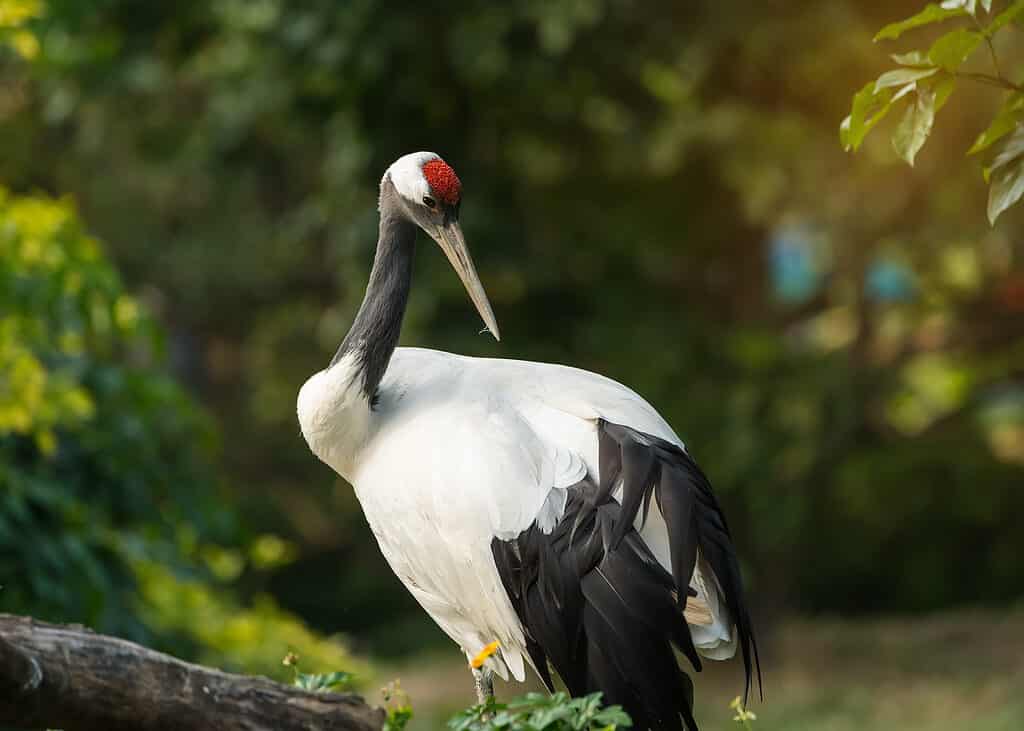
Cranes were named for their characteristic hoarse cry; they can be found across five continents
©asharkyu/Shutterstock.com
Fifteen different species of these birds live across five continents. All of these magnificent birds belong to the class Aves, order Gruiformes, superfamily Gruoidea, and family Gruidae. The name crane is of Germanic origin, the words Kran in German and kraan in Dutch. At the same time in history, in the 16th century, the world developed through Middle English as crane. The word means to “cry hoarsely.” Now, the word is also used to describe someone stretching out their neck or limbs like the bird, as in, “He craned his neck.”
Evolution
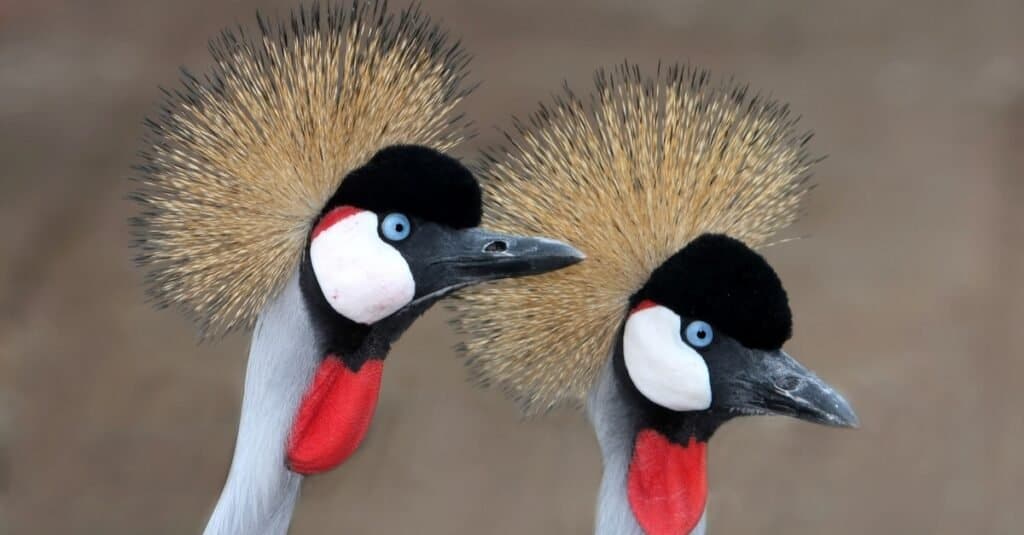
Asian and Africa are home to the greatest varieties of crane species
©Four Oaks/Shutterstock.com
As part of the order Gruiformes, cranes are also related to rails also known as Rallidae, finfoots or Heliornithidae and limpkins or Psophiidae. Scientists believe that the existing genera of cranes including Antigone, Balearica, Grus, and Leucogeranus, emerged on the evolutionary scene about 20 million years ago during the early part of the Miocene (which itself lasted between 5.33 – 23 million years ago).
Asia is home to the largest number of species – eight. Next in line is Africa, which is home to five species, two of which are somewhat arboreal, while North America is home to two – as is Australia.
Types

Cranes are capable of growing to almost 6 feet in height and weighing 26 lbs
©Kent Ellington/Shutterstock.com
Subspecies of these birds and their warm-season habitats include:
- Common crane: This avian is capable of measuring 51 inches in length and weighing over 13 lbs. It has a wingspan of about 8 feet and is the only species found in Europe.
- Red-crowned crane: Known for the patch of red skin on their crowns, these birds are capable of growing to 5 feet 2 inches in height and weighing up to 23 lbs. They can be found in east Asia.
- Sandhill crane: This species has a maximum height of 4 feet 6 inches and an average weight of 10 lbs. It is generally gray and can be found in Siberia and North America.
- Sarus crane: Its claim to fame is its status as the tallest flying bird with a maximum height of 5 feet 11 inches. Found in India, Southern Asia, and Australia, it is capable of weighing up to 26 lbs.
- Whooping crane: This species is capable of reaching a height of 5 feet 3 inches and weighing 19 lbs. Its wingspan is about 7 feet 7 inches and it is native to North America.
- Demoiselle Crane of northwest Africa, Ukraine and southern Russia, central and eastern Asia
- Blue Crane of South Africa and Namibia
- Wattled Crane of Ethiopia, South Africa, and southern Africa
- Siberian Crane of western Siberia and northeastern Siberia
- Hooded Crane of northeastern China and southeastern Russia
- Black Crowned Crane of western and eastern Africa
- Grey Crowned Crane of southern and eastern Africa
- Brolga, Australian Crane of Australia and northern New Guinea
- White Naped Crane of Mongolia, northeastern China, far eastern Russia
- Black Necked Crane of northern India, western China, and central China
Appearance & Behavior

The sarus crane is the longest flying bird in the world.
©Mukund Kumar/Shutterstock.com
Thes birds are the world’s tallest flying birds that range in size from only 35 inches long to 69 inches long. The Demoiselle – is the smallest and Sarus Crane is the longest. But the heaviest one is the Red-Crowned Japanese Crane, which weighs up to 26 pounds before flying south for the winter or north for summer. The birds all have long legs, long necks, large wings, and streamlined bodies. They vary in wingspan, with their wings having a rounded appearance. Males and females look the same, but males are a bit larger.
The feathers and markings vary according to their habitat. Open wetland birds typically feature more white in their coloration than species from forests or small wetlands. The birds living in the forest or small wetland habitats feature more grey. The white birds generally grow larger, too. Smaller forest birds with their darker coloring can blend into their environment better while nesting. Of these forest dwellers, Sandhill – and common cranes apply mud to their feathers to better hide from predators.
All of these bird types except the Blue and Demoiselle cranes feature bare skin on their faces. They use this skin to communicate with other birds by expanding and relaxing their muscles. This activity also changes the color of their face. Blue, Wattled, and Demoiselle cranes can move the feathers on their head to signal their flock, too.
These birds have special throat features that help them communicate, too. Some have a shorter windpipe that only presses gently upon a bone in their chest. Others have a longer windpipe that presses deeply into the bone in their chest. Still other species of cranes have fused bones of the windpipe and chest that give more power to their calls. In this last group, the calls can travel for as far as several miles.
These birds’ calls include a large vocabulary. They start learning these special calls that work like human language from the time they hatch. Their first calls beg for food from parents and signal that they are content or need parents’ attention. They soon learn alarm calls and calls signal that they are about to launch into flight. They recognize each other by their calls and even form duets.
During breeding season, these birds become very territorial and stay on their own territory full time. During non-breeding season, many species of these birds form large flocks, socialize, engage with each other and feed together. The birds that eat mostly plants feed in flocks, but the ones eating meat feed in family groups and rejoin the flock for rest or travel. It is important for these birds to stick together in groups to keep them safe when resting, protect their young and socialize.
Habitat
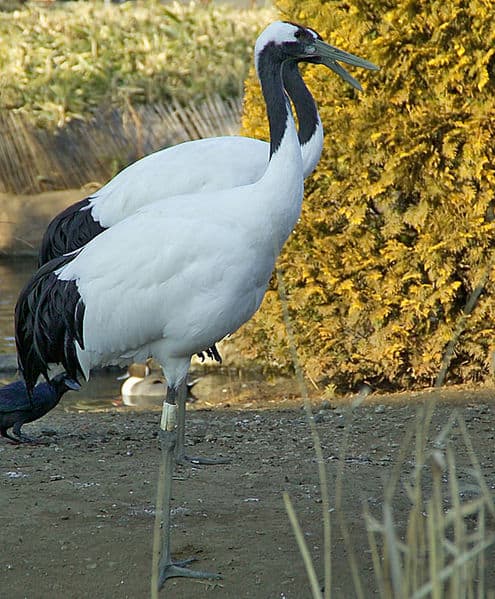
Cranes can be found on every continent except Antarctica and South America
©Fg2 – Public Domain
These birds live on all continents except South America and Antarctica. Africa and East Asia have the most variety for these birds living in one region. Africa has eight species, whereas East Asia has six during its peak season. With 15 different species among the broader family of cranes, each type has its own preferred habitat.
Most of them need wetlands for their survival, as well as broad, open areas. The majority also nest in the shallows of wetlands, while some nest there but move their chicks to grassy lands for daytime feeding. Only the two types of African crowned cranes do not roost in wetlands. Instead, they roost in trees.
Not all of these birds migrate with changing seasons. Some are sedentary, which means they stay in one region throughout the year. Of those that fly to warmer weather for winter, many travel thousands of miles to their breeding habitats.
Diet
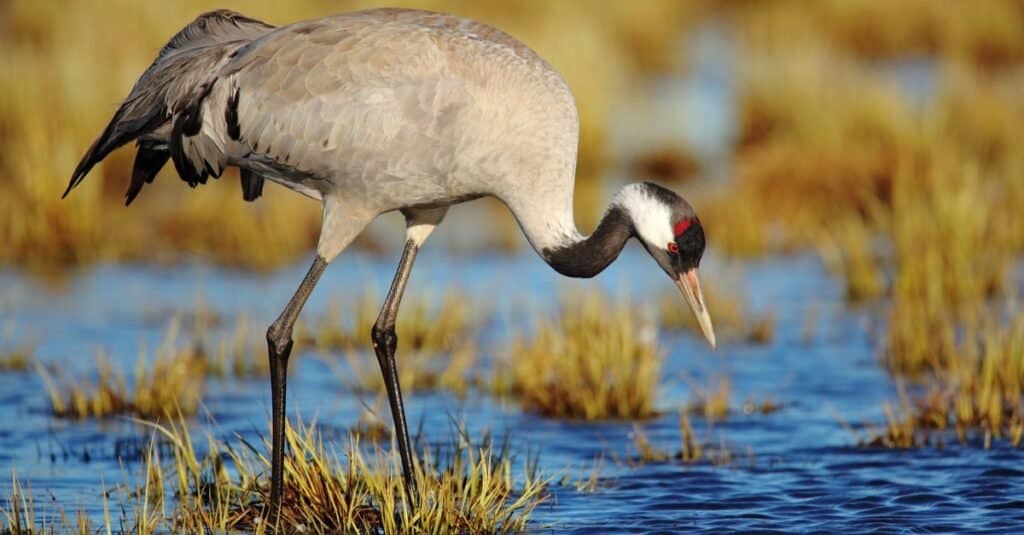
Different crane species in the same area select different feeding areas to prevent competition for food sources
©Ondrej Prosicky/Shutterstock.com
These birds are omnivores. They can eat both animals and plants. Preferred foods on land include seeds, nuts, acorns, leaves, berries, and fruit. They also eat insects, birds, small reptiles, small mammals, snails, and worms. While living in wetlands, they feed on roots, tubers, rhizomes, snails, frogs, and small fish. Their diet is highly adaptable according to their location, time of year, and food availability. However, the birds with shorter beaks prefer dry upland foods and the ones with longer bills prefer wetland foods.
The birds feeding in wetlands dig for tubers and rhizomes. This requires them to stay in one place for a long period of time as they dig and expand a hole searching for these foods. They also lower their heads and move very slowly forward with their bills probing for insects and small animals.
To reduce competition, two species living near each other adopt their own habitats. This prevents overfeeding on available foods and ensures all have access to nutrition. For example, in China, Siberian cranes feed in shallow water and mudflats while their neighboring White Naped cranes feed on the edges of the wetlands. At the same time, Hooded cranes in this same area feed on meadows and agricultural fields, sharing the fields with common Eurasian cranes.
Predators & Threats
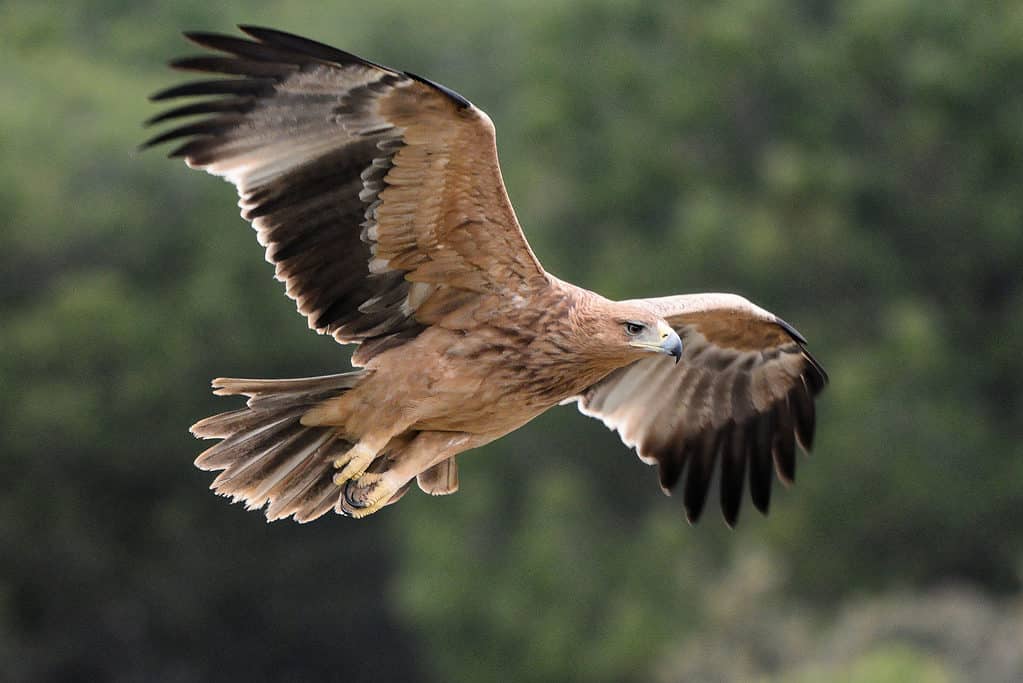
Eagles are some of the few predators capable of targeting cranes
©LABETAA Andre/Shutterstock.com
Because adult birds are so large, few predators challenge them in their natural habitats. But some predators do exist and include other large birds of prey, such as owls and eagles. They also include foxes and wildcats. Chicks are highly vulnerable to these ground-based predators.
People take over their habitat and threaten these birds through urbanization. This affects population numbers by driving cranes away from their breeding, roosting, nesting, and feeding grounds.
Reproduction, Babies, & Lifespan
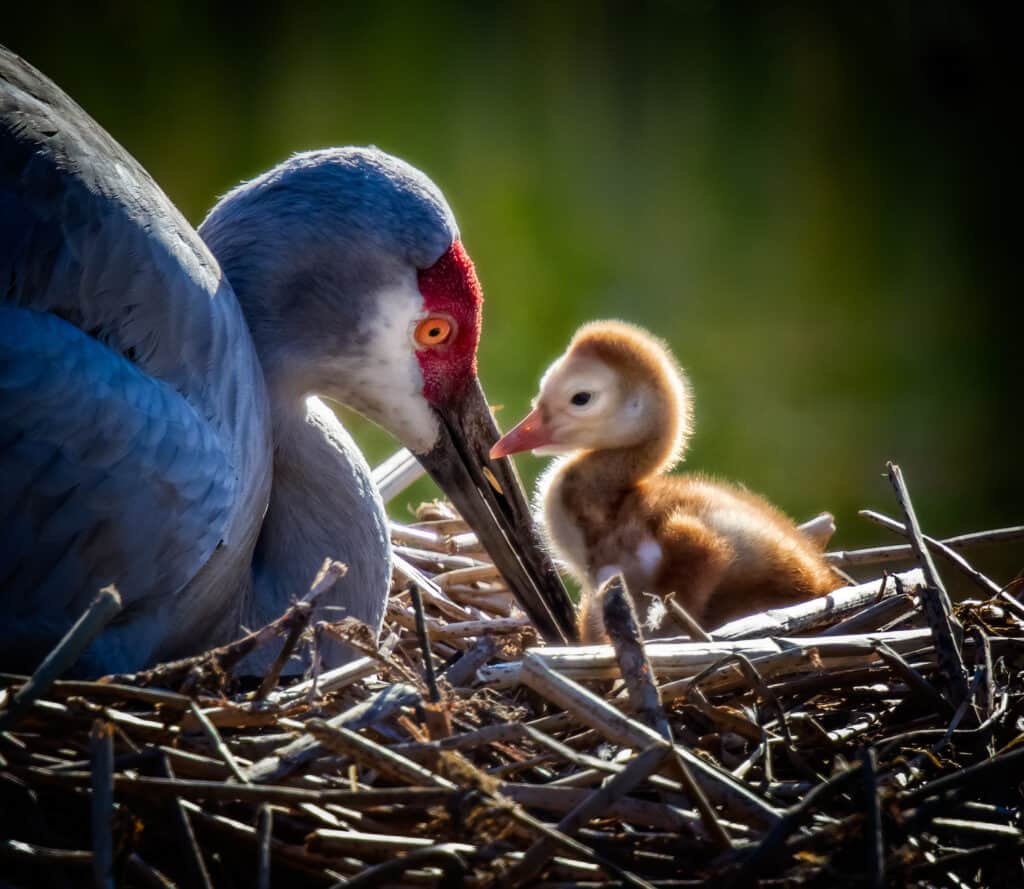
Both parents are involved in caring for the young
©jo Crebbin/Shutterstock.com
These birds are monogamous. This means they have a lifelong mate. They typically find this mate during their second or third year of life. But they do not successfully breed for several years. To attract a mate, young birds perform a mating dance. They flap their wings, bow, jump, and throw small sticks or plants.
During their first breeding attempts they often fail. Sometimes this period of failure leads to a “divorce” of the birds to find new mates. As long as they breed successfully, a male and female will stay together in their lifelong pairing.
Scientists studied Sandhill cranes in Florida. Of these 22 pairs, seven couples stayed together for 11 years. Of the 15 that did not stay together, just over half of the relationships ended because of one of the birds’ death. About 18 percent of the birds divorced and scientists could not track 29 percent of the pairs.
These birds breed according to the individual breeding season of their species. The season depends on local climate and conditions. Migrating birds breed immediately upon arriving in their summer habitat from late spring to early summer. Tropical birds typically prefer to breed during wet or monsoon seasons.
The eggs hatch about a month after laying. When the chicks hatch, their parents feed them until the babies can fly away from the nest. This is typically after two months. Young birds can reproduce at three to five years of age.
Wild birds typically live for 20 to 30 years. In captivity, a Siberian crane lived for 83 years.
Population
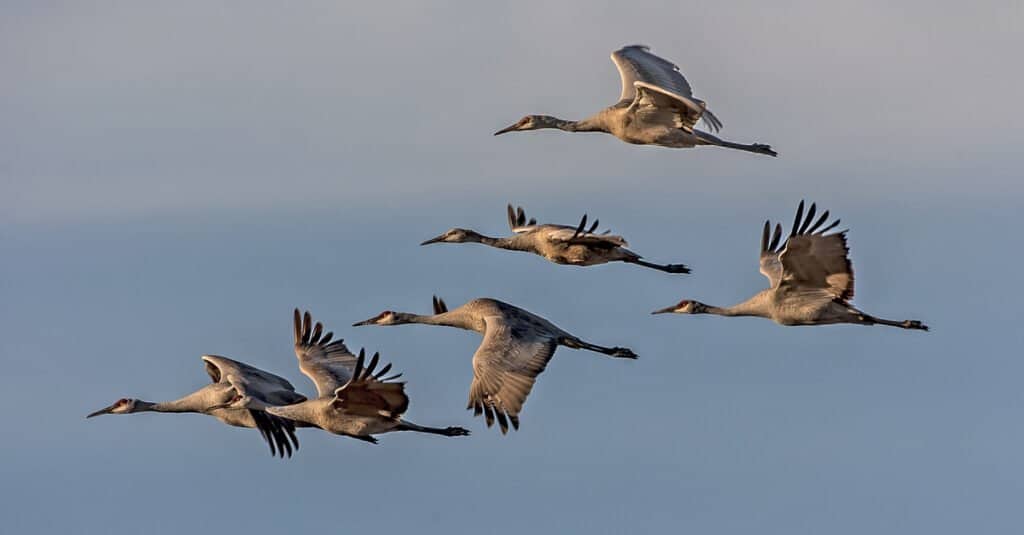
Several crane species are threatened or endangered
©Tom Zeman/Shutterstock.com
Because there are so many types of these birds, the population varies widely. Conservation status also depends on the individual species.
Below is the conservation status of each of the 15 types of cranes in the world today, according to the International Union for Conservation of Nature:
- Eurasian (Common) Crane has a population of 590,000 to 660,000 birds and is listed as non-threatened.
- Sandhill Crane has a population of 670,000 to 830,000 birds and is listed as non-threatened.
- Demoiselle Crane has a population of 200,000 to 240,000 birds and is listed as non-threatened.
- Blue Crane has a population of 25,000 to 30,000 birds and is listed as threatened.
- Wattled Crane has a population of 6,500 to 8,100 birds and is listed as threatened.
- Siberian Crane has a population of 3,500 to 3,800 birds and is listed as critically endangered.
- Hooded Crane has a population of 11,550 to 11,650 birds and is listed as threatened.
- Whooping Crane has a population of 300 to 310 birds and is listed as endangered.
- Black Crowned Crane has a population of 33,000 to 70,000 birds and is listed as threatened.
- Grey Crowned Crane has a population of 32,000 to 49,000 birds and is listed as endangered.
- Sarus Crane has a population of 24,300 to 26,800 birds and is listed as threatened.
- Brolga, Australian Crane has a population of 35,000 to 100,000 birds and is listed as non-threatened.
- White Naped Crane has a population of 5,500 to 6,500 birds and is listed as threatened.
- Red Crowned Japanese Crane has a population of 2,510 to 2,600 birds and is listed as endangered.
- Black Necked Crane has a population of 10,000 to 11,000 birds and is listed as threatened.
Crane FAQs (Frequently Asked Questions)
Are cranes carnivores, herbivores, or omnivores?
Cranes are omnivores. They eat a wide range of plants and animals, usually according to where they live and what food is readily available. They enjoy seeds, tubers, nuts, acorns, leaves, berries and fruit. They also enjoy small birds, rodents, frogs, snails and mollusks.
In folklore, what does it mean when you see a crane?
In folklore, a crane is a symbol of good luck, justice and longevity. The bird also represents one’s own inner and outer beauty, as well as music and dance creativity. In some Asian cultures, a crane is believed to be a messenger from Heaven, able to travel back to the hereafter.
What is the difference between a crane and a heron?
Herons and cranes are both large birds that often live in wetlands. But the heron flies with a bent neck while the crane flies with an extended neck.
How many years does a crane live?
In the wild, if cranes survive their first difficult two years, they can live 20 to 30 years. In captivity, one Siberian crane lived for 83 years, but more commonly these birds live for 30 years when in human care.
How do cranes sleep?
Cranes sleep at night while standing on the ground. Most do this in shallow water with one leg raised like a flamingo. They typically tuck their heads and necks in, such as under the shoulder of one wing. When not breeding, most cranes roost in flocks for protection.
What Kingdom do Cranes belong to?
Cranes belong to the Kingdom Animalia.
What phylum do Cranes belong to?
Cranes belong to the phylum Chordata.
What class do Cranes belong to?
Cranes belong to the class Aves.
What family do Cranes belong to?
Cranes belong to the family Gruidae.
What order do Cranes belong to?
Cranes belong to the order Gruiformes.
What type of covering do Cranes have?
Cranes are covered in Feathers.
In what type of habitat do Cranes live?
Cranes live in temperate wetlands.
What is the main prey for Cranes?
Cranes prey on insects, fish, and grains.
What are some distinguishing features of Cranes?
Cranes have large bodies and long beaks.
What are some predators of Cranes?
Predators of Cranes include foxes, eagles, and wildcats.
What is the average clutch size of a Crane?
Cranes typically lay 4 eggs.
What is an interesting fact about Cranes?
Many Cranes are critically endangered species!
What is the scientific name for the Crane?
The scientific name for the Crane is Gruidae.
What is the Crane's wingspan?
The Crane has a wingspan of 1.8m to 2.4m (71in to 95in).
How fast is a Crane?
A Crane can travel at speeds of up to 25 miles per hour.
How do Cranes have babies?
Cranes lay eggs.
What's the difference between a crane and a stork?
The key differences between a crane and a stork are their taxonomy, physical features, behavior, diet, and lifespan. While cranes belong to the Gruiformes order, storks belong to the Ciconiidae order. Besides, storks are generally shorter but bigger than cranes.
How to say Crane in ...
Thank you for reading! Have some feedback for us? Contact the AZ Animals editorial team.
Sources
- David Burnie, Dorling Kindersley (2011) Animal, The Definitive Visual Guide To The World's Wildlife
- Tom Jackson, Lorenz Books (2007) The World Encyclopedia Of Animals
- David Burnie, Kingfisher (2011) The Kingfisher Animal Encyclopedia
- Richard Mackay, University of California Press (2009) The Atlas Of Endangered Species
- David Burnie, Dorling Kindersley (2008) Illustrated Encyclopedia Of Animals
- Dorling Kindersley (2006) Dorling Kindersley Encyclopedia Of Animals
- Christopher Perrins, Oxford University Press (2009) The Encyclopedia Of Birds

















